Organisational Behaviour Report: Impact of OB on P&G's Performance
VerifiedAdded on 2023/06/08
|16
|5590
|221
Report
AI Summary
This report provides an in-depth analysis of organisational behaviour principles, focusing on their application within Procter & Gamble (P&G). It begins by examining how organisational culture, power structures, and political dynamics influence individual and team performance, drawing upon Handy's cultural model and French and Raven's forms of power. The report then evaluates content and process theories of motivation, including Maslow's hierarchy of needs, Herzberg's two-factor theory, and Vroom's expectancy theory, to assess how P&G can motivate employees and achieve its goals. Furthermore, the report explores team development theories to understand how to transform ineffective teams into effective ones. Finally, it applies these organisational behaviour concepts to a given business situation, offering recommendations to improve workplace productivity and performance, culminating in a critical evaluation of the relevance of team development theories and their impact on influencing behaviour for increasing productivity.
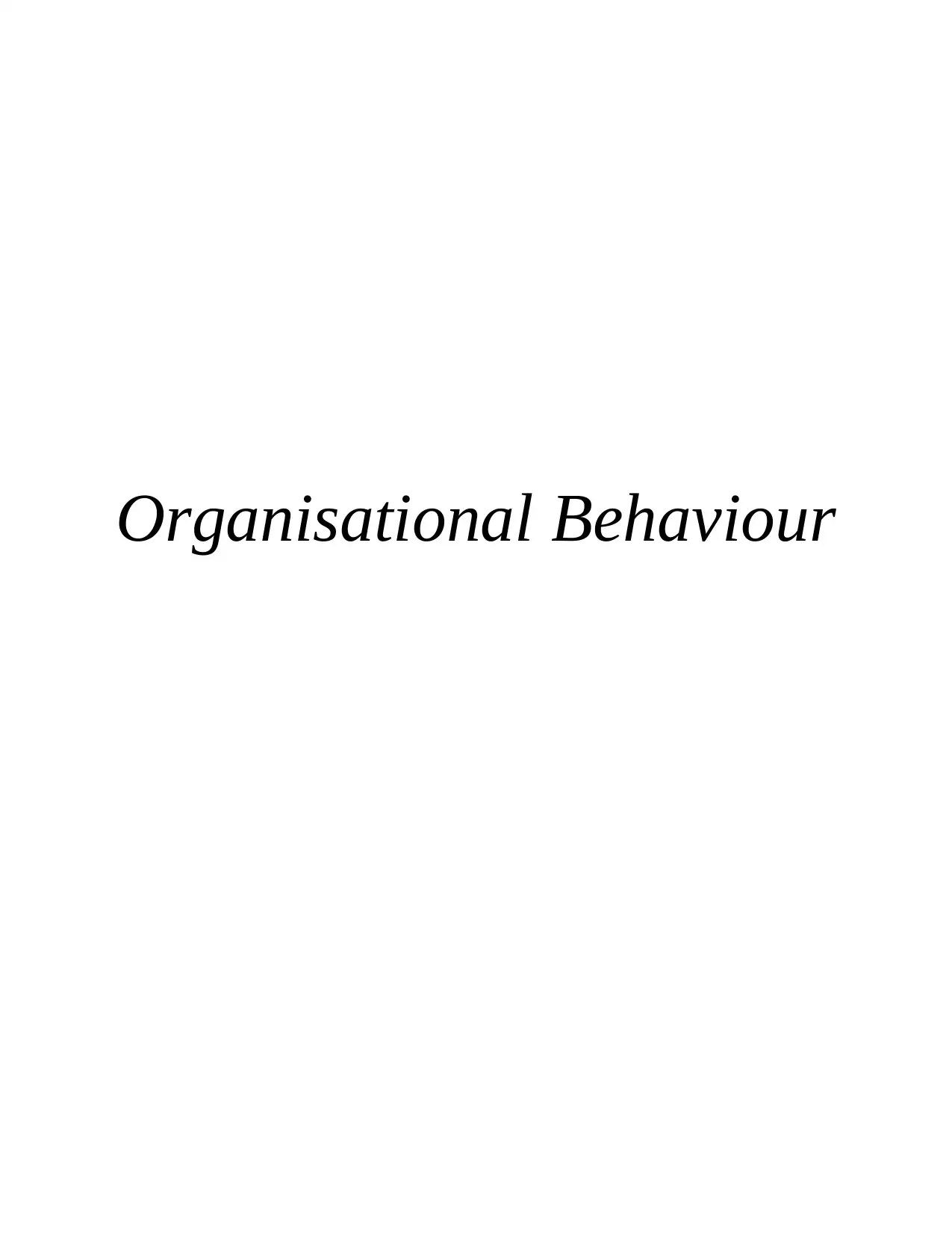
Organisational Behaviour
Paraphrase This Document
Need a fresh take? Get an instant paraphrase of this document with our AI Paraphraser
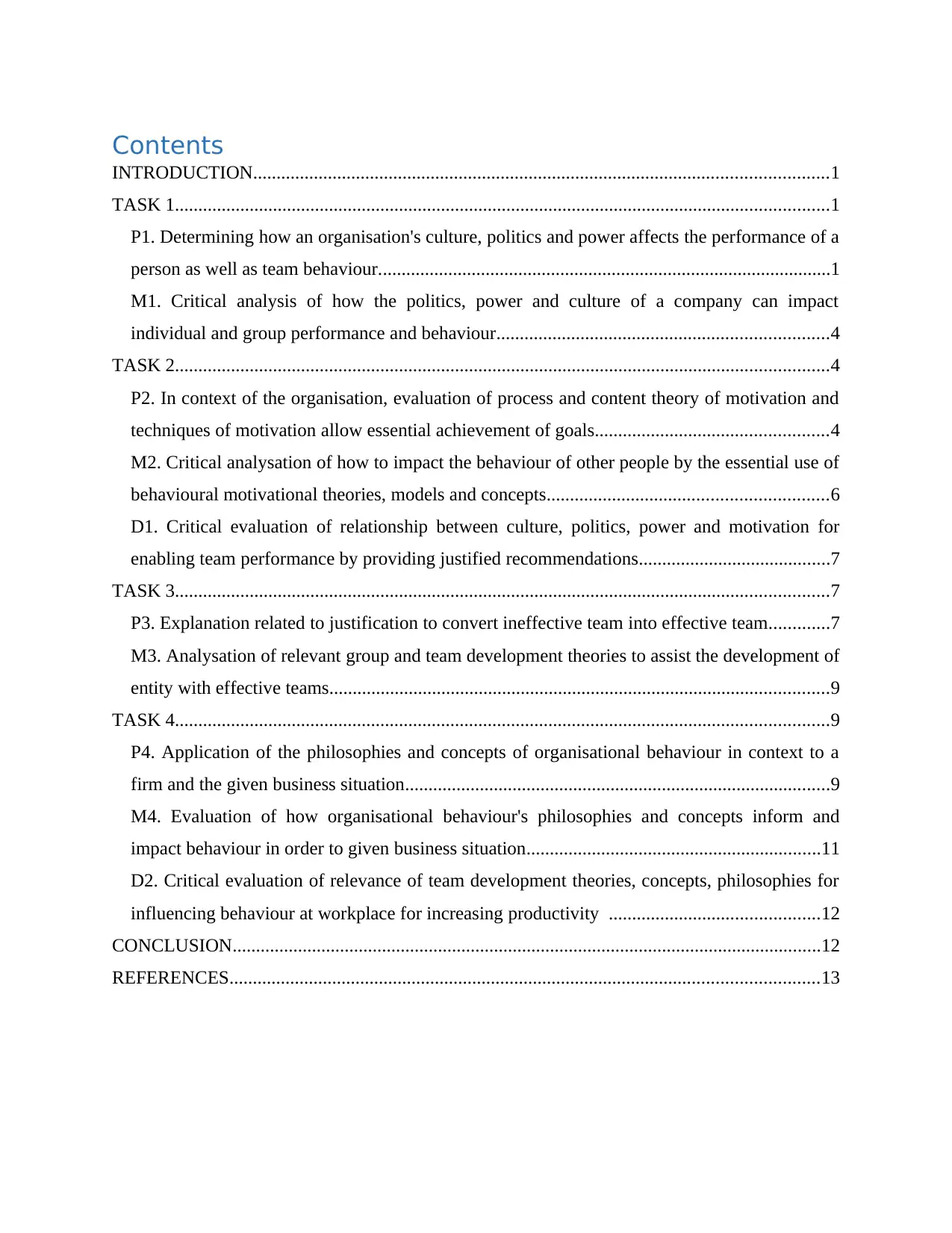
Contents
INTRODUCTION...........................................................................................................................1
TASK 1............................................................................................................................................1
P1. Determining how an organisation's culture, politics and power affects the performance of a
person as well as team behaviour.................................................................................................1
M1. Critical analysis of how the politics, power and culture of a company can impact
individual and group performance and behaviour.......................................................................4
TASK 2............................................................................................................................................4
P2. In context of the organisation, evaluation of process and content theory of motivation and
techniques of motivation allow essential achievement of goals..................................................4
M2. Critical analysation of how to impact the behaviour of other people by the essential use of
behavioural motivational theories, models and concepts............................................................6
D1. Critical evaluation of relationship between culture, politics, power and motivation for
enabling team performance by providing justified recommendations.........................................7
TASK 3............................................................................................................................................7
P3. Explanation related to justification to convert ineffective team into effective team.............7
M3. Analysation of relevant group and team development theories to assist the development of
entity with effective teams...........................................................................................................9
TASK 4............................................................................................................................................9
P4. Application of the philosophies and concepts of organisational behaviour in context to a
firm and the given business situation...........................................................................................9
M4. Evaluation of how organisational behaviour's philosophies and concepts inform and
impact behaviour in order to given business situation...............................................................11
D2. Critical evaluation of relevance of team development theories, concepts, philosophies for
influencing behaviour at workplace for increasing productivity .............................................12
CONCLUSION..............................................................................................................................12
REFERENCES..............................................................................................................................13
INTRODUCTION...........................................................................................................................1
TASK 1............................................................................................................................................1
P1. Determining how an organisation's culture, politics and power affects the performance of a
person as well as team behaviour.................................................................................................1
M1. Critical analysis of how the politics, power and culture of a company can impact
individual and group performance and behaviour.......................................................................4
TASK 2............................................................................................................................................4
P2. In context of the organisation, evaluation of process and content theory of motivation and
techniques of motivation allow essential achievement of goals..................................................4
M2. Critical analysation of how to impact the behaviour of other people by the essential use of
behavioural motivational theories, models and concepts............................................................6
D1. Critical evaluation of relationship between culture, politics, power and motivation for
enabling team performance by providing justified recommendations.........................................7
TASK 3............................................................................................................................................7
P3. Explanation related to justification to convert ineffective team into effective team.............7
M3. Analysation of relevant group and team development theories to assist the development of
entity with effective teams...........................................................................................................9
TASK 4............................................................................................................................................9
P4. Application of the philosophies and concepts of organisational behaviour in context to a
firm and the given business situation...........................................................................................9
M4. Evaluation of how organisational behaviour's philosophies and concepts inform and
impact behaviour in order to given business situation...............................................................11
D2. Critical evaluation of relevance of team development theories, concepts, philosophies for
influencing behaviour at workplace for increasing productivity .............................................12
CONCLUSION..............................................................................................................................12
REFERENCES..............................................................................................................................13
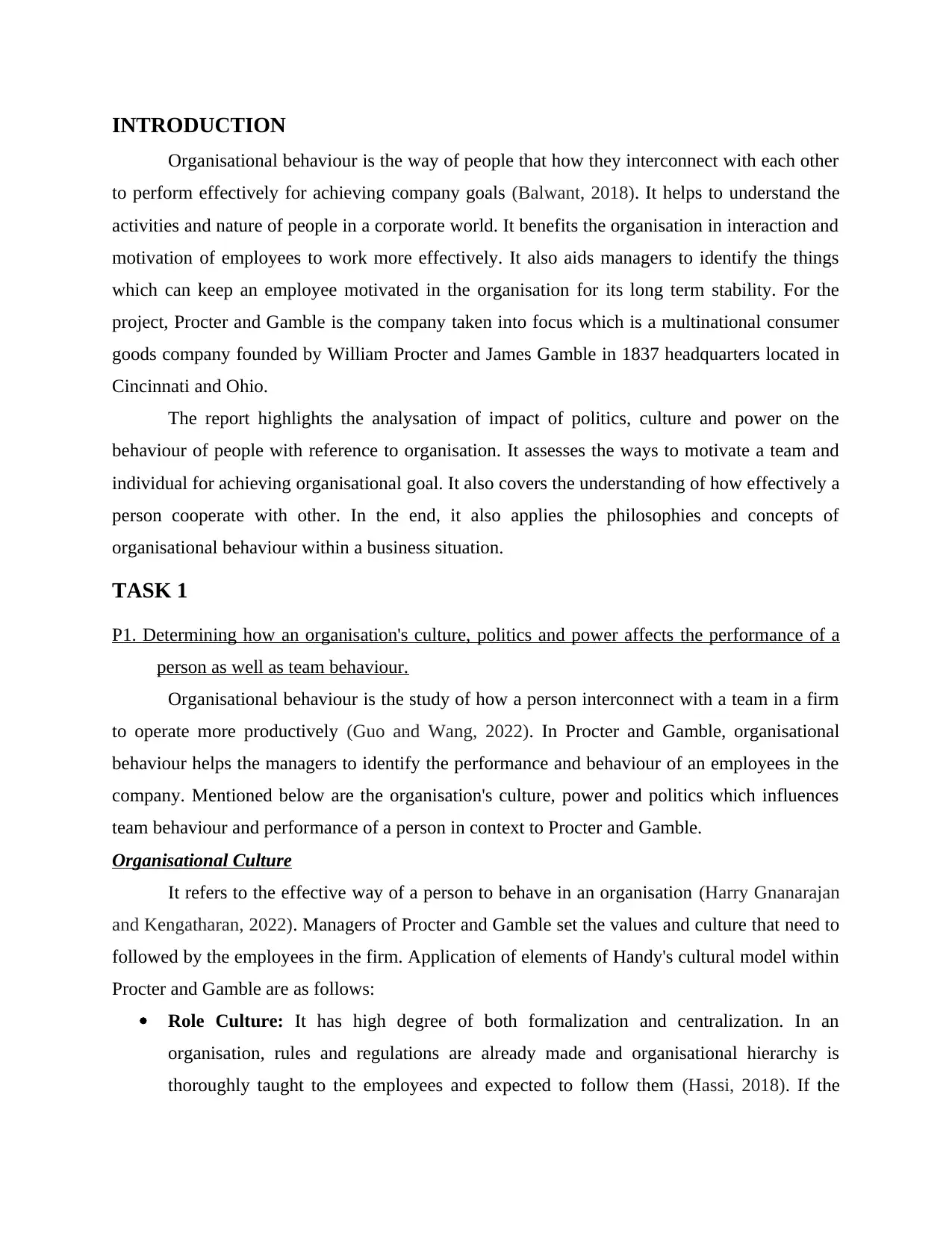
INTRODUCTION
Organisational behaviour is the way of people that how they interconnect with each other
to perform effectively for achieving company goals (Balwant, 2018). It helps to understand the
activities and nature of people in a corporate world. It benefits the organisation in interaction and
motivation of employees to work more effectively. It also aids managers to identify the things
which can keep an employee motivated in the organisation for its long term stability. For the
project, Procter and Gamble is the company taken into focus which is a multinational consumer
goods company founded by William Procter and James Gamble in 1837 headquarters located in
Cincinnati and Ohio.
The report highlights the analysation of impact of politics, culture and power on the
behaviour of people with reference to organisation. It assesses the ways to motivate a team and
individual for achieving organisational goal. It also covers the understanding of how effectively a
person cooperate with other. In the end, it also applies the philosophies and concepts of
organisational behaviour within a business situation.
TASK 1
P1. Determining how an organisation's culture, politics and power affects the performance of a
person as well as team behaviour.
Organisational behaviour is the study of how a person interconnect with a team in a firm
to operate more productively (Guo and Wang, 2022). In Procter and Gamble, organisational
behaviour helps the managers to identify the performance and behaviour of an employees in the
company. Mentioned below are the organisation's culture, power and politics which influences
team behaviour and performance of a person in context to Procter and Gamble.
Organisational Culture
It refers to the effective way of a person to behave in an organisation (Harry Gnanarajan
and Kengatharan, 2022). Managers of Procter and Gamble set the values and culture that need to
followed by the employees in the firm. Application of elements of Handy's cultural model within
Procter and Gamble are as follows:
Role Culture: It has high degree of both formalization and centralization. In an
organisation, rules and regulations are already made and organisational hierarchy is
thoroughly taught to the employees and expected to follow them (Hassi, 2018). If the
Organisational behaviour is the way of people that how they interconnect with each other
to perform effectively for achieving company goals (Balwant, 2018). It helps to understand the
activities and nature of people in a corporate world. It benefits the organisation in interaction and
motivation of employees to work more effectively. It also aids managers to identify the things
which can keep an employee motivated in the organisation for its long term stability. For the
project, Procter and Gamble is the company taken into focus which is a multinational consumer
goods company founded by William Procter and James Gamble in 1837 headquarters located in
Cincinnati and Ohio.
The report highlights the analysation of impact of politics, culture and power on the
behaviour of people with reference to organisation. It assesses the ways to motivate a team and
individual for achieving organisational goal. It also covers the understanding of how effectively a
person cooperate with other. In the end, it also applies the philosophies and concepts of
organisational behaviour within a business situation.
TASK 1
P1. Determining how an organisation's culture, politics and power affects the performance of a
person as well as team behaviour.
Organisational behaviour is the study of how a person interconnect with a team in a firm
to operate more productively (Guo and Wang, 2022). In Procter and Gamble, organisational
behaviour helps the managers to identify the performance and behaviour of an employees in the
company. Mentioned below are the organisation's culture, power and politics which influences
team behaviour and performance of a person in context to Procter and Gamble.
Organisational Culture
It refers to the effective way of a person to behave in an organisation (Harry Gnanarajan
and Kengatharan, 2022). Managers of Procter and Gamble set the values and culture that need to
followed by the employees in the firm. Application of elements of Handy's cultural model within
Procter and Gamble are as follows:
Role Culture: It has high degree of both formalization and centralization. In an
organisation, rules and regulations are already made and organisational hierarchy is
thoroughly taught to the employees and expected to follow them (Hassi, 2018). If the
⊘ This is a preview!⊘
Do you want full access?
Subscribe today to unlock all pages.

Trusted by 1+ million students worldwide
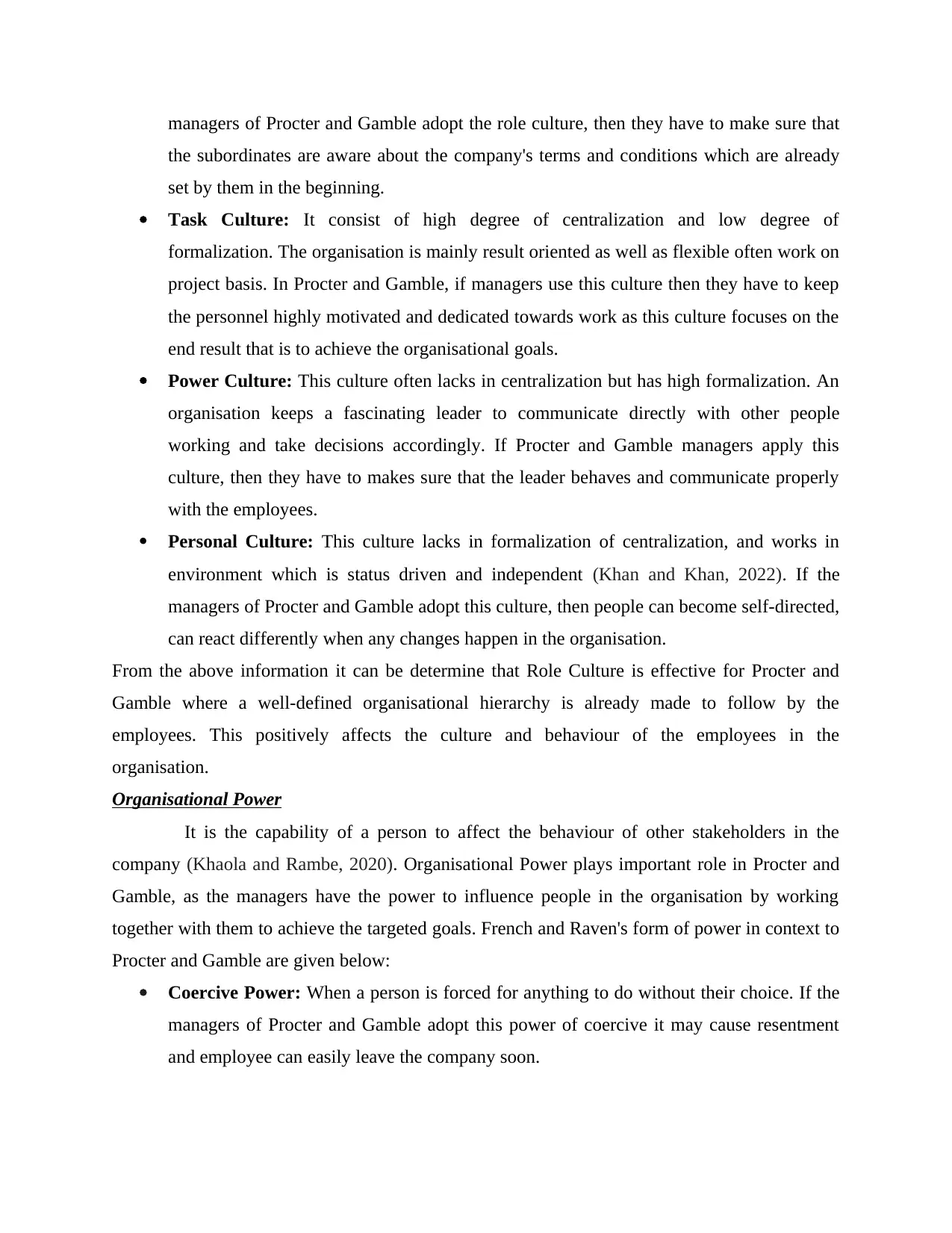
managers of Procter and Gamble adopt the role culture, then they have to make sure that
the subordinates are aware about the company's terms and conditions which are already
set by them in the beginning.
Task Culture: It consist of high degree of centralization and low degree of
formalization. The organisation is mainly result oriented as well as flexible often work on
project basis. In Procter and Gamble, if managers use this culture then they have to keep
the personnel highly motivated and dedicated towards work as this culture focuses on the
end result that is to achieve the organisational goals.
Power Culture: This culture often lacks in centralization but has high formalization. An
organisation keeps a fascinating leader to communicate directly with other people
working and take decisions accordingly. If Procter and Gamble managers apply this
culture, then they have to makes sure that the leader behaves and communicate properly
with the employees.
Personal Culture: This culture lacks in formalization of centralization, and works in
environment which is status driven and independent (Khan and Khan, 2022). If the
managers of Procter and Gamble adopt this culture, then people can become self-directed,
can react differently when any changes happen in the organisation.
From the above information it can be determine that Role Culture is effective for Procter and
Gamble where a well-defined organisational hierarchy is already made to follow by the
employees. This positively affects the culture and behaviour of the employees in the
organisation.
Organisational Power
It is the capability of a person to affect the behaviour of other stakeholders in the
company (Khaola and Rambe, 2020). Organisational Power plays important role in Procter and
Gamble, as the managers have the power to influence people in the organisation by working
together with them to achieve the targeted goals. French and Raven's form of power in context to
Procter and Gamble are given below:
Coercive Power: When a person is forced for anything to do without their choice. If the
managers of Procter and Gamble adopt this power of coercive it may cause resentment
and employee can easily leave the company soon.
the subordinates are aware about the company's terms and conditions which are already
set by them in the beginning.
Task Culture: It consist of high degree of centralization and low degree of
formalization. The organisation is mainly result oriented as well as flexible often work on
project basis. In Procter and Gamble, if managers use this culture then they have to keep
the personnel highly motivated and dedicated towards work as this culture focuses on the
end result that is to achieve the organisational goals.
Power Culture: This culture often lacks in centralization but has high formalization. An
organisation keeps a fascinating leader to communicate directly with other people
working and take decisions accordingly. If Procter and Gamble managers apply this
culture, then they have to makes sure that the leader behaves and communicate properly
with the employees.
Personal Culture: This culture lacks in formalization of centralization, and works in
environment which is status driven and independent (Khan and Khan, 2022). If the
managers of Procter and Gamble adopt this culture, then people can become self-directed,
can react differently when any changes happen in the organisation.
From the above information it can be determine that Role Culture is effective for Procter and
Gamble where a well-defined organisational hierarchy is already made to follow by the
employees. This positively affects the culture and behaviour of the employees in the
organisation.
Organisational Power
It is the capability of a person to affect the behaviour of other stakeholders in the
company (Khaola and Rambe, 2020). Organisational Power plays important role in Procter and
Gamble, as the managers have the power to influence people in the organisation by working
together with them to achieve the targeted goals. French and Raven's form of power in context to
Procter and Gamble are given below:
Coercive Power: When a person is forced for anything to do without their choice. If the
managers of Procter and Gamble adopt this power of coercive it may cause resentment
and employee can easily leave the company soon.
Paraphrase This Document
Need a fresh take? Get an instant paraphrase of this document with our AI Paraphraser
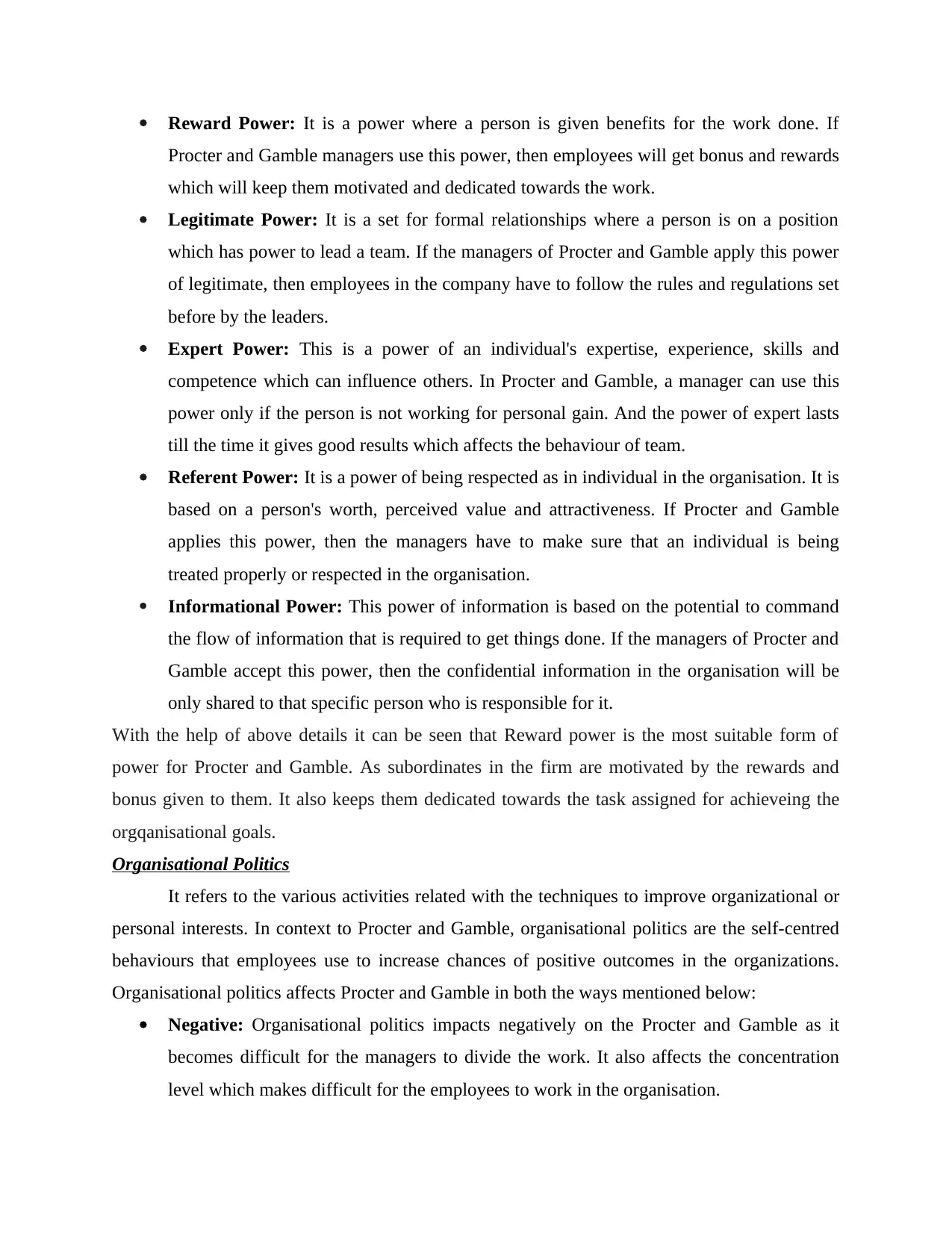
Reward Power: It is a power where a person is given benefits for the work done. If
Procter and Gamble managers use this power, then employees will get bonus and rewards
which will keep them motivated and dedicated towards the work.
Legitimate Power: It is a set for formal relationships where a person is on a position
which has power to lead a team. If the managers of Procter and Gamble apply this power
of legitimate, then employees in the company have to follow the rules and regulations set
before by the leaders.
Expert Power: This is a power of an individual's expertise, experience, skills and
competence which can influence others. In Procter and Gamble, a manager can use this
power only if the person is not working for personal gain. And the power of expert lasts
till the time it gives good results which affects the behaviour of team.
Referent Power: It is a power of being respected as in individual in the organisation. It is
based on a person's worth, perceived value and attractiveness. If Procter and Gamble
applies this power, then the managers have to make sure that an individual is being
treated properly or respected in the organisation.
Informational Power: This power of information is based on the potential to command
the flow of information that is required to get things done. If the managers of Procter and
Gamble accept this power, then the confidential information in the organisation will be
only shared to that specific person who is responsible for it.
With the help of above details it can be seen that Reward power is the most suitable form of
power for Procter and Gamble. As subordinates in the firm are motivated by the rewards and
bonus given to them. It also keeps them dedicated towards the task assigned for achieveing the
orgqanisational goals.
Organisational Politics
It refers to the various activities related with the techniques to improve organizational or
personal interests. In context to Procter and Gamble, organisational politics are the self-centred
behaviours that employees use to increase chances of positive outcomes in the organizations.
Organisational politics affects Procter and Gamble in both the ways mentioned below:
Negative: Organisational politics impacts negatively on the Procter and Gamble as it
becomes difficult for the managers to divide the work. It also affects the concentration
level which makes difficult for the employees to work in the organisation.
Procter and Gamble managers use this power, then employees will get bonus and rewards
which will keep them motivated and dedicated towards the work.
Legitimate Power: It is a set for formal relationships where a person is on a position
which has power to lead a team. If the managers of Procter and Gamble apply this power
of legitimate, then employees in the company have to follow the rules and regulations set
before by the leaders.
Expert Power: This is a power of an individual's expertise, experience, skills and
competence which can influence others. In Procter and Gamble, a manager can use this
power only if the person is not working for personal gain. And the power of expert lasts
till the time it gives good results which affects the behaviour of team.
Referent Power: It is a power of being respected as in individual in the organisation. It is
based on a person's worth, perceived value and attractiveness. If Procter and Gamble
applies this power, then the managers have to make sure that an individual is being
treated properly or respected in the organisation.
Informational Power: This power of information is based on the potential to command
the flow of information that is required to get things done. If the managers of Procter and
Gamble accept this power, then the confidential information in the organisation will be
only shared to that specific person who is responsible for it.
With the help of above details it can be seen that Reward power is the most suitable form of
power for Procter and Gamble. As subordinates in the firm are motivated by the rewards and
bonus given to them. It also keeps them dedicated towards the task assigned for achieveing the
orgqanisational goals.
Organisational Politics
It refers to the various activities related with the techniques to improve organizational or
personal interests. In context to Procter and Gamble, organisational politics are the self-centred
behaviours that employees use to increase chances of positive outcomes in the organizations.
Organisational politics affects Procter and Gamble in both the ways mentioned below:
Negative: Organisational politics impacts negatively on the Procter and Gamble as it
becomes difficult for the managers to divide the work. It also affects the concentration
level which makes difficult for the employees to work in the organisation.
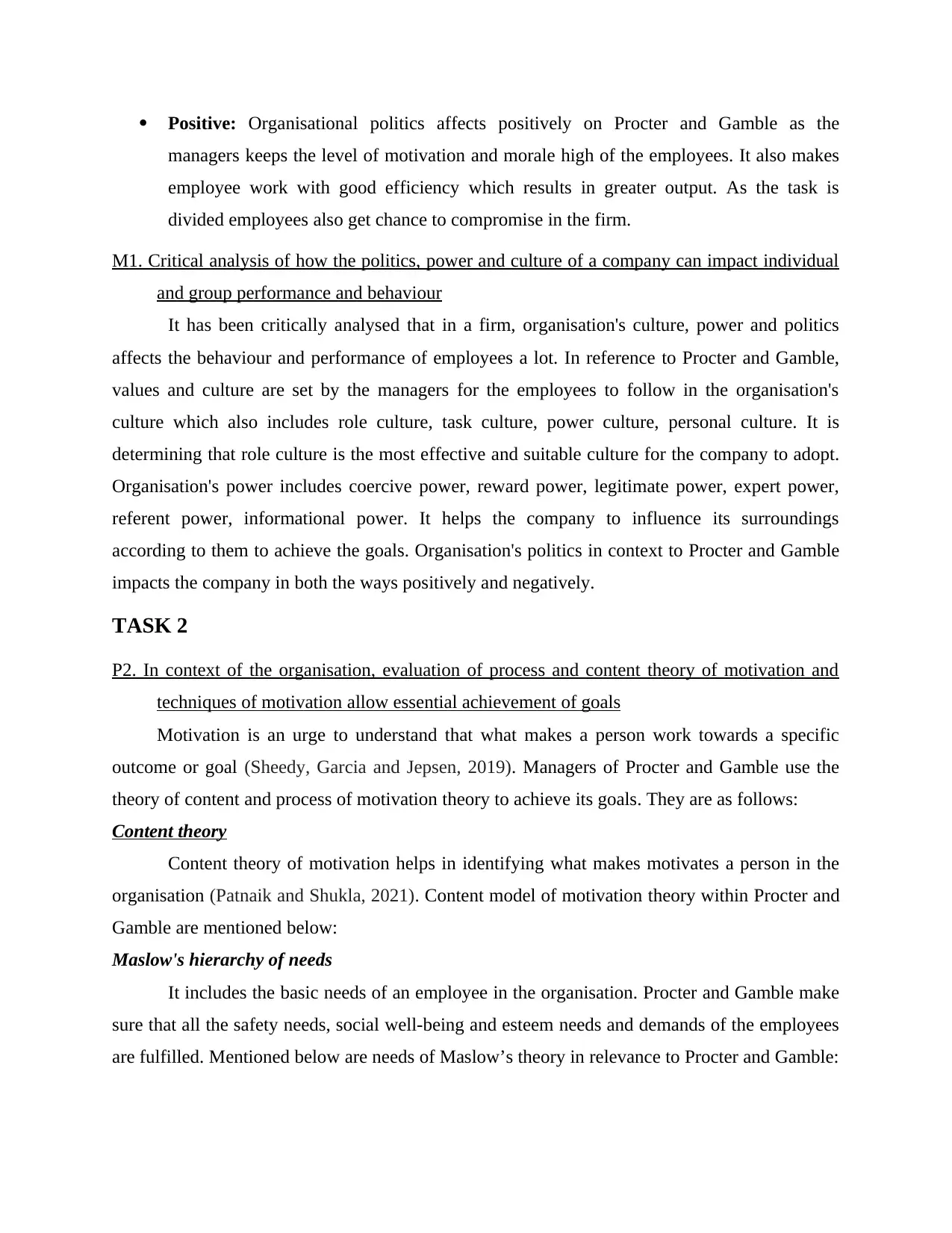
Positive: Organisational politics affects positively on Procter and Gamble as the
managers keeps the level of motivation and morale high of the employees. It also makes
employee work with good efficiency which results in greater output. As the task is
divided employees also get chance to compromise in the firm.
M1. Critical analysis of how the politics, power and culture of a company can impact individual
and group performance and behaviour
It has been critically analysed that in a firm, organisation's culture, power and politics
affects the behaviour and performance of employees a lot. In reference to Procter and Gamble,
values and culture are set by the managers for the employees to follow in the organisation's
culture which also includes role culture, task culture, power culture, personal culture. It is
determining that role culture is the most effective and suitable culture for the company to adopt.
Organisation's power includes coercive power, reward power, legitimate power, expert power,
referent power, informational power. It helps the company to influence its surroundings
according to them to achieve the goals. Organisation's politics in context to Procter and Gamble
impacts the company in both the ways positively and negatively.
TASK 2
P2. In context of the organisation, evaluation of process and content theory of motivation and
techniques of motivation allow essential achievement of goals
Motivation is an urge to understand that what makes a person work towards a specific
outcome or goal (Sheedy, Garcia and Jepsen, 2019). Managers of Procter and Gamble use the
theory of content and process of motivation theory to achieve its goals. They are as follows:
Content theory
Content theory of motivation helps in identifying what makes motivates a person in the
organisation (Patnaik and Shukla, 2021). Content model of motivation theory within Procter and
Gamble are mentioned below:
Maslow's hierarchy of needs
It includes the basic needs of an employee in the organisation. Procter and Gamble make
sure that all the safety needs, social well-being and esteem needs and demands of the employees
are fulfilled. Mentioned below are needs of Maslow’s theory in relevance to Procter and Gamble:
managers keeps the level of motivation and morale high of the employees. It also makes
employee work with good efficiency which results in greater output. As the task is
divided employees also get chance to compromise in the firm.
M1. Critical analysis of how the politics, power and culture of a company can impact individual
and group performance and behaviour
It has been critically analysed that in a firm, organisation's culture, power and politics
affects the behaviour and performance of employees a lot. In reference to Procter and Gamble,
values and culture are set by the managers for the employees to follow in the organisation's
culture which also includes role culture, task culture, power culture, personal culture. It is
determining that role culture is the most effective and suitable culture for the company to adopt.
Organisation's power includes coercive power, reward power, legitimate power, expert power,
referent power, informational power. It helps the company to influence its surroundings
according to them to achieve the goals. Organisation's politics in context to Procter and Gamble
impacts the company in both the ways positively and negatively.
TASK 2
P2. In context of the organisation, evaluation of process and content theory of motivation and
techniques of motivation allow essential achievement of goals
Motivation is an urge to understand that what makes a person work towards a specific
outcome or goal (Sheedy, Garcia and Jepsen, 2019). Managers of Procter and Gamble use the
theory of content and process of motivation theory to achieve its goals. They are as follows:
Content theory
Content theory of motivation helps in identifying what makes motivates a person in the
organisation (Patnaik and Shukla, 2021). Content model of motivation theory within Procter and
Gamble are mentioned below:
Maslow's hierarchy of needs
It includes the basic needs of an employee in the organisation. Procter and Gamble make
sure that all the safety needs, social well-being and esteem needs and demands of the employees
are fulfilled. Mentioned below are needs of Maslow’s theory in relevance to Procter and Gamble:
⊘ This is a preview!⊘
Do you want full access?
Subscribe today to unlock all pages.

Trusted by 1+ million students worldwide
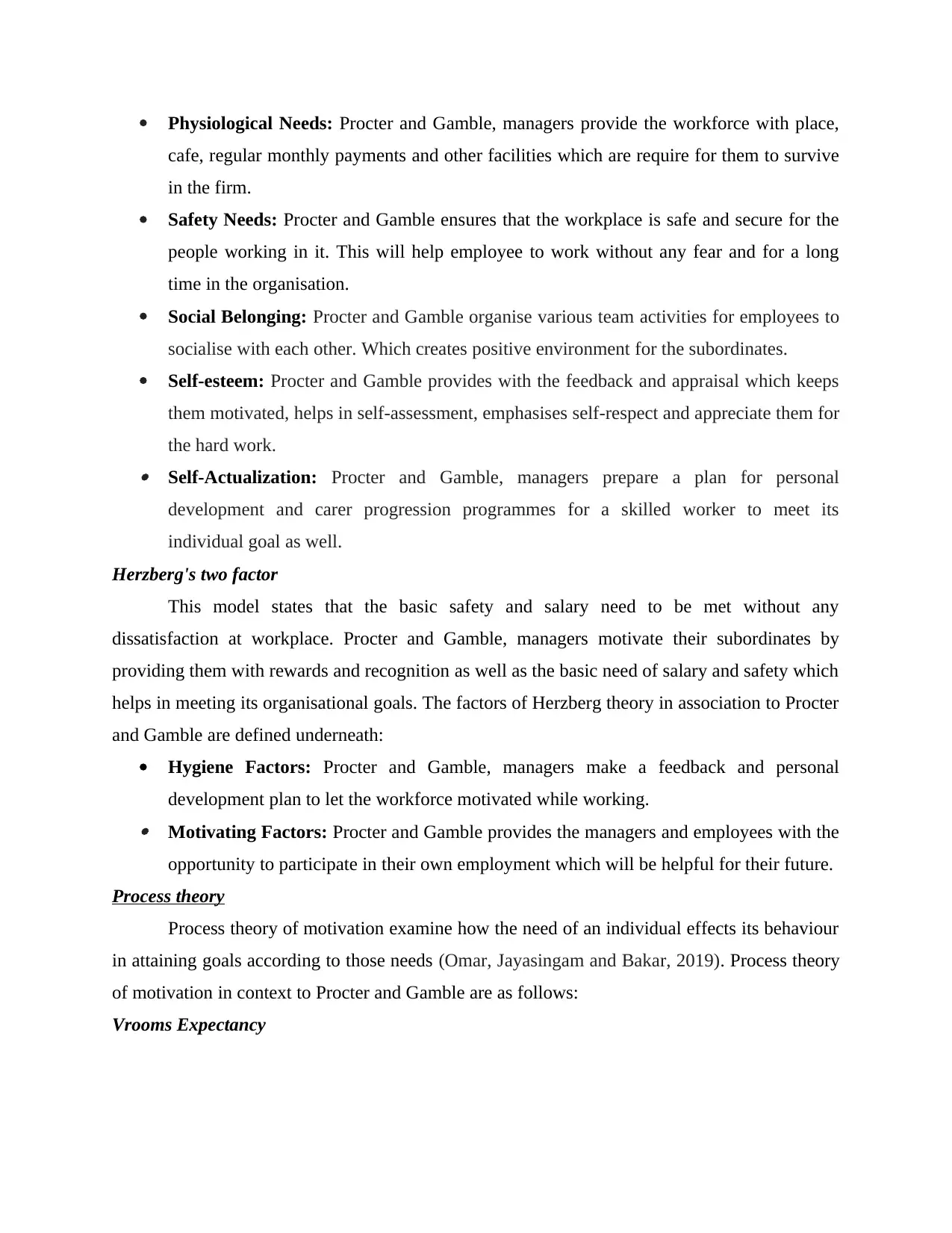
Physiological Needs: Procter and Gamble, managers provide the workforce with place,
cafe, regular monthly payments and other facilities which are require for them to survive
in the firm.
Safety Needs: Procter and Gamble ensures that the workplace is safe and secure for the
people working in it. This will help employee to work without any fear and for a long
time in the organisation.
Social Belonging: Procter and Gamble organise various team activities for employees to
socialise with each other. Which creates positive environment for the subordinates.
Self-esteem: Procter and Gamble provides with the feedback and appraisal which keeps
them motivated, helps in self-assessment, emphasises self-respect and appreciate them for
the hard work. Self-Actualization: Procter and Gamble, managers prepare a plan for personal
development and carer progression programmes for a skilled worker to meet its
individual goal as well.
Herzberg's two factor
This model states that the basic safety and salary need to be met without any
dissatisfaction at workplace. Procter and Gamble, managers motivate their subordinates by
providing them with rewards and recognition as well as the basic need of salary and safety which
helps in meeting its organisational goals. The factors of Herzberg theory in association to Procter
and Gamble are defined underneath:
Hygiene Factors: Procter and Gamble, managers make a feedback and personal
development plan to let the workforce motivated while working. Motivating Factors: Procter and Gamble provides the managers and employees with the
opportunity to participate in their own employment which will be helpful for their future.
Process theory
Process theory of motivation examine how the need of an individual effects its behaviour
in attaining goals according to those needs (Omar, Jayasingam and Bakar, 2019). Process theory
of motivation in context to Procter and Gamble are as follows:
Vrooms Expectancy
cafe, regular monthly payments and other facilities which are require for them to survive
in the firm.
Safety Needs: Procter and Gamble ensures that the workplace is safe and secure for the
people working in it. This will help employee to work without any fear and for a long
time in the organisation.
Social Belonging: Procter and Gamble organise various team activities for employees to
socialise with each other. Which creates positive environment for the subordinates.
Self-esteem: Procter and Gamble provides with the feedback and appraisal which keeps
them motivated, helps in self-assessment, emphasises self-respect and appreciate them for
the hard work. Self-Actualization: Procter and Gamble, managers prepare a plan for personal
development and carer progression programmes for a skilled worker to meet its
individual goal as well.
Herzberg's two factor
This model states that the basic safety and salary need to be met without any
dissatisfaction at workplace. Procter and Gamble, managers motivate their subordinates by
providing them with rewards and recognition as well as the basic need of salary and safety which
helps in meeting its organisational goals. The factors of Herzberg theory in association to Procter
and Gamble are defined underneath:
Hygiene Factors: Procter and Gamble, managers make a feedback and personal
development plan to let the workforce motivated while working. Motivating Factors: Procter and Gamble provides the managers and employees with the
opportunity to participate in their own employment which will be helpful for their future.
Process theory
Process theory of motivation examine how the need of an individual effects its behaviour
in attaining goals according to those needs (Omar, Jayasingam and Bakar, 2019). Process theory
of motivation in context to Procter and Gamble are as follows:
Vrooms Expectancy
Paraphrase This Document
Need a fresh take? Get an instant paraphrase of this document with our AI Paraphraser
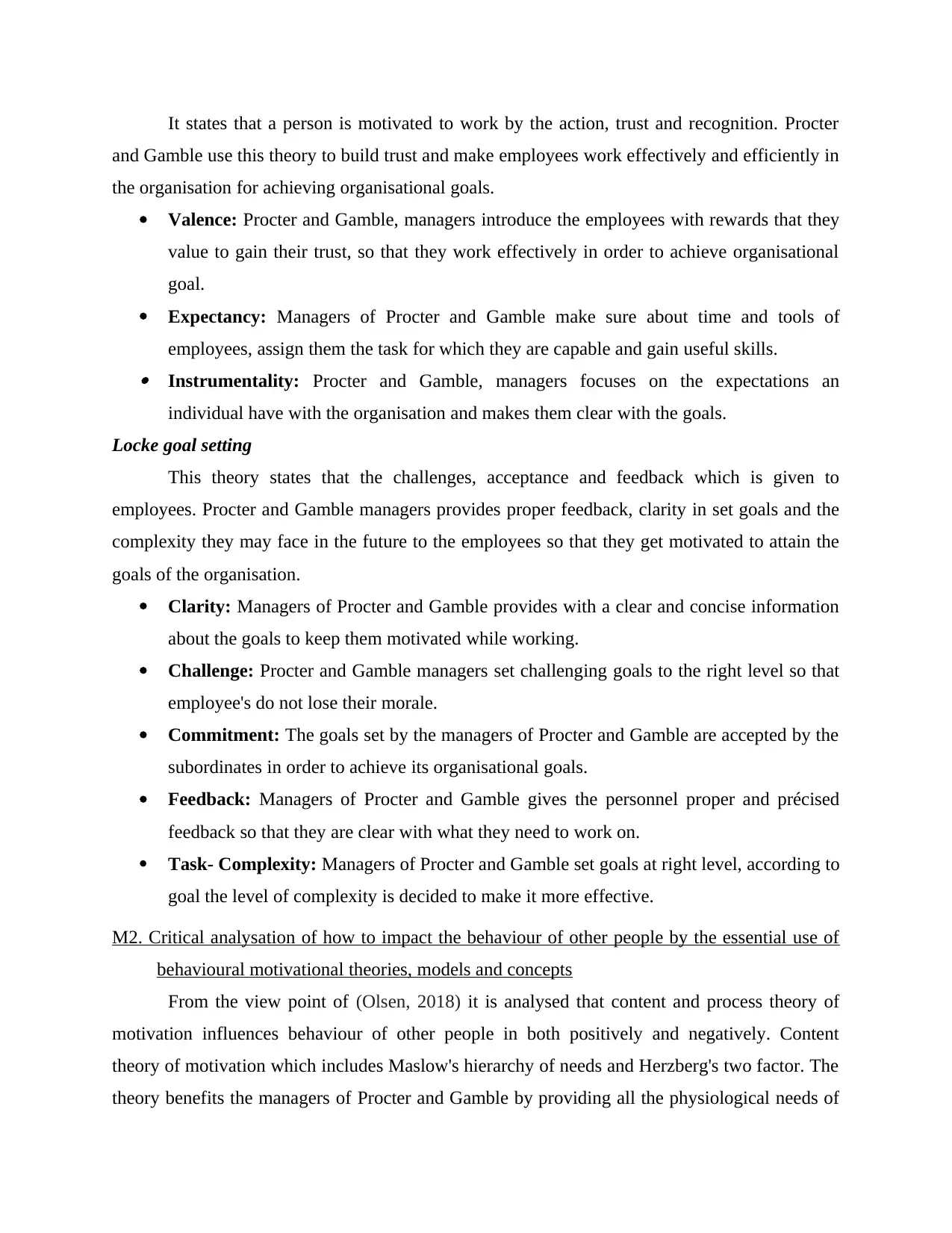
It states that a person is motivated to work by the action, trust and recognition. Procter
and Gamble use this theory to build trust and make employees work effectively and efficiently in
the organisation for achieving organisational goals.
Valence: Procter and Gamble, managers introduce the employees with rewards that they
value to gain their trust, so that they work effectively in order to achieve organisational
goal.
Expectancy: Managers of Procter and Gamble make sure about time and tools of
employees, assign them the task for which they are capable and gain useful skills. Instrumentality: Procter and Gamble, managers focuses on the expectations an
individual have with the organisation and makes them clear with the goals.
Locke goal setting
This theory states that the challenges, acceptance and feedback which is given to
employees. Procter and Gamble managers provides proper feedback, clarity in set goals and the
complexity they may face in the future to the employees so that they get motivated to attain the
goals of the organisation.
Clarity: Managers of Procter and Gamble provides with a clear and concise information
about the goals to keep them motivated while working.
Challenge: Procter and Gamble managers set challenging goals to the right level so that
employee's do not lose their morale.
Commitment: The goals set by the managers of Procter and Gamble are accepted by the
subordinates in order to achieve its organisational goals.
Feedback: Managers of Procter and Gamble gives the personnel proper and précised
feedback so that they are clear with what they need to work on.
Task- Complexity: Managers of Procter and Gamble set goals at right level, according to
goal the level of complexity is decided to make it more effective.
M2. Critical analysation of how to impact the behaviour of other people by the essential use of
behavioural motivational theories, models and concepts
From the view point of (Olsen, 2018) it is analysed that content and process theory of
motivation influences behaviour of other people in both positively and negatively. Content
theory of motivation which includes Maslow's hierarchy of needs and Herzberg's two factor. The
theory benefits the managers of Procter and Gamble by providing all the physiological needs of
and Gamble use this theory to build trust and make employees work effectively and efficiently in
the organisation for achieving organisational goals.
Valence: Procter and Gamble, managers introduce the employees with rewards that they
value to gain their trust, so that they work effectively in order to achieve organisational
goal.
Expectancy: Managers of Procter and Gamble make sure about time and tools of
employees, assign them the task for which they are capable and gain useful skills. Instrumentality: Procter and Gamble, managers focuses on the expectations an
individual have with the organisation and makes them clear with the goals.
Locke goal setting
This theory states that the challenges, acceptance and feedback which is given to
employees. Procter and Gamble managers provides proper feedback, clarity in set goals and the
complexity they may face in the future to the employees so that they get motivated to attain the
goals of the organisation.
Clarity: Managers of Procter and Gamble provides with a clear and concise information
about the goals to keep them motivated while working.
Challenge: Procter and Gamble managers set challenging goals to the right level so that
employee's do not lose their morale.
Commitment: The goals set by the managers of Procter and Gamble are accepted by the
subordinates in order to achieve its organisational goals.
Feedback: Managers of Procter and Gamble gives the personnel proper and précised
feedback so that they are clear with what they need to work on.
Task- Complexity: Managers of Procter and Gamble set goals at right level, according to
goal the level of complexity is decided to make it more effective.
M2. Critical analysation of how to impact the behaviour of other people by the essential use of
behavioural motivational theories, models and concepts
From the view point of (Olsen, 2018) it is analysed that content and process theory of
motivation influences behaviour of other people in both positively and negatively. Content
theory of motivation which includes Maslow's hierarchy of needs and Herzberg's two factor. The
theory benefits the managers of Procter and Gamble by providing all the physiological needs of
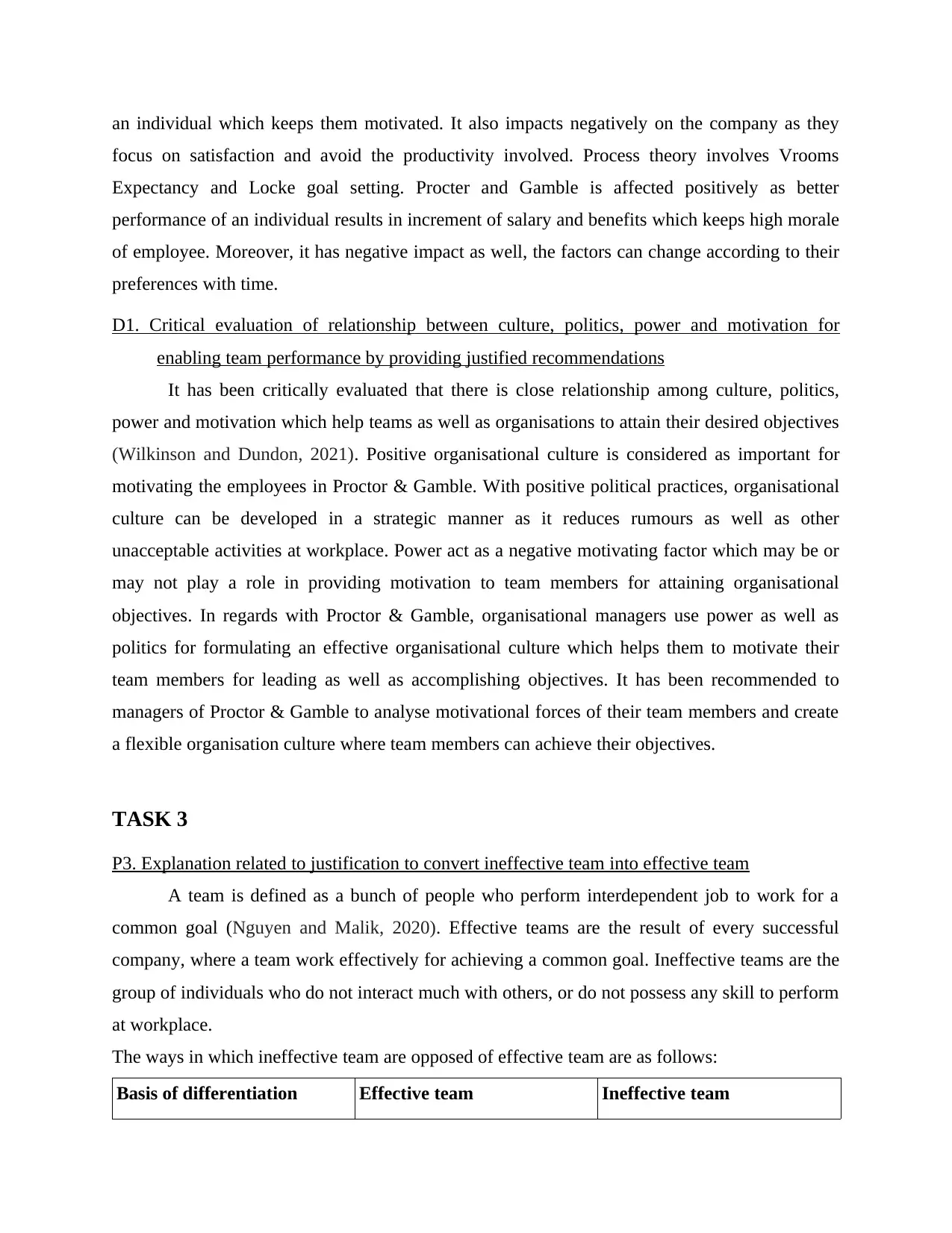
an individual which keeps them motivated. It also impacts negatively on the company as they
focus on satisfaction and avoid the productivity involved. Process theory involves Vrooms
Expectancy and Locke goal setting. Procter and Gamble is affected positively as better
performance of an individual results in increment of salary and benefits which keeps high morale
of employee. Moreover, it has negative impact as well, the factors can change according to their
preferences with time.
D1. Critical evaluation of relationship between culture, politics, power and motivation for
enabling team performance by providing justified recommendations
It has been critically evaluated that there is close relationship among culture, politics,
power and motivation which help teams as well as organisations to attain their desired objectives
(Wilkinson and Dundon, 2021). Positive organisational culture is considered as important for
motivating the employees in Proctor & Gamble. With positive political practices, organisational
culture can be developed in a strategic manner as it reduces rumours as well as other
unacceptable activities at workplace. Power act as a negative motivating factor which may be or
may not play a role in providing motivation to team members for attaining organisational
objectives. In regards with Proctor & Gamble, organisational managers use power as well as
politics for formulating an effective organisational culture which helps them to motivate their
team members for leading as well as accomplishing objectives. It has been recommended to
managers of Proctor & Gamble to analyse motivational forces of their team members and create
a flexible organisation culture where team members can achieve their objectives.
TASK 3
P3. Explanation related to justification to convert ineffective team into effective team
A team is defined as a bunch of people who perform interdependent job to work for a
common goal (Nguyen and Malik, 2020). Effective teams are the result of every successful
company, where a team work effectively for achieving a common goal. Ineffective teams are the
group of individuals who do not interact much with others, or do not possess any skill to perform
at workplace.
The ways in which ineffective team are opposed of effective team are as follows:
Basis of differentiation Effective team Ineffective team
focus on satisfaction and avoid the productivity involved. Process theory involves Vrooms
Expectancy and Locke goal setting. Procter and Gamble is affected positively as better
performance of an individual results in increment of salary and benefits which keeps high morale
of employee. Moreover, it has negative impact as well, the factors can change according to their
preferences with time.
D1. Critical evaluation of relationship between culture, politics, power and motivation for
enabling team performance by providing justified recommendations
It has been critically evaluated that there is close relationship among culture, politics,
power and motivation which help teams as well as organisations to attain their desired objectives
(Wilkinson and Dundon, 2021). Positive organisational culture is considered as important for
motivating the employees in Proctor & Gamble. With positive political practices, organisational
culture can be developed in a strategic manner as it reduces rumours as well as other
unacceptable activities at workplace. Power act as a negative motivating factor which may be or
may not play a role in providing motivation to team members for attaining organisational
objectives. In regards with Proctor & Gamble, organisational managers use power as well as
politics for formulating an effective organisational culture which helps them to motivate their
team members for leading as well as accomplishing objectives. It has been recommended to
managers of Proctor & Gamble to analyse motivational forces of their team members and create
a flexible organisation culture where team members can achieve their objectives.
TASK 3
P3. Explanation related to justification to convert ineffective team into effective team
A team is defined as a bunch of people who perform interdependent job to work for a
common goal (Nguyen and Malik, 2020). Effective teams are the result of every successful
company, where a team work effectively for achieving a common goal. Ineffective teams are the
group of individuals who do not interact much with others, or do not possess any skill to perform
at workplace.
The ways in which ineffective team are opposed of effective team are as follows:
Basis of differentiation Effective team Ineffective team
⊘ This is a preview!⊘
Do you want full access?
Subscribe today to unlock all pages.

Trusted by 1+ million students worldwide
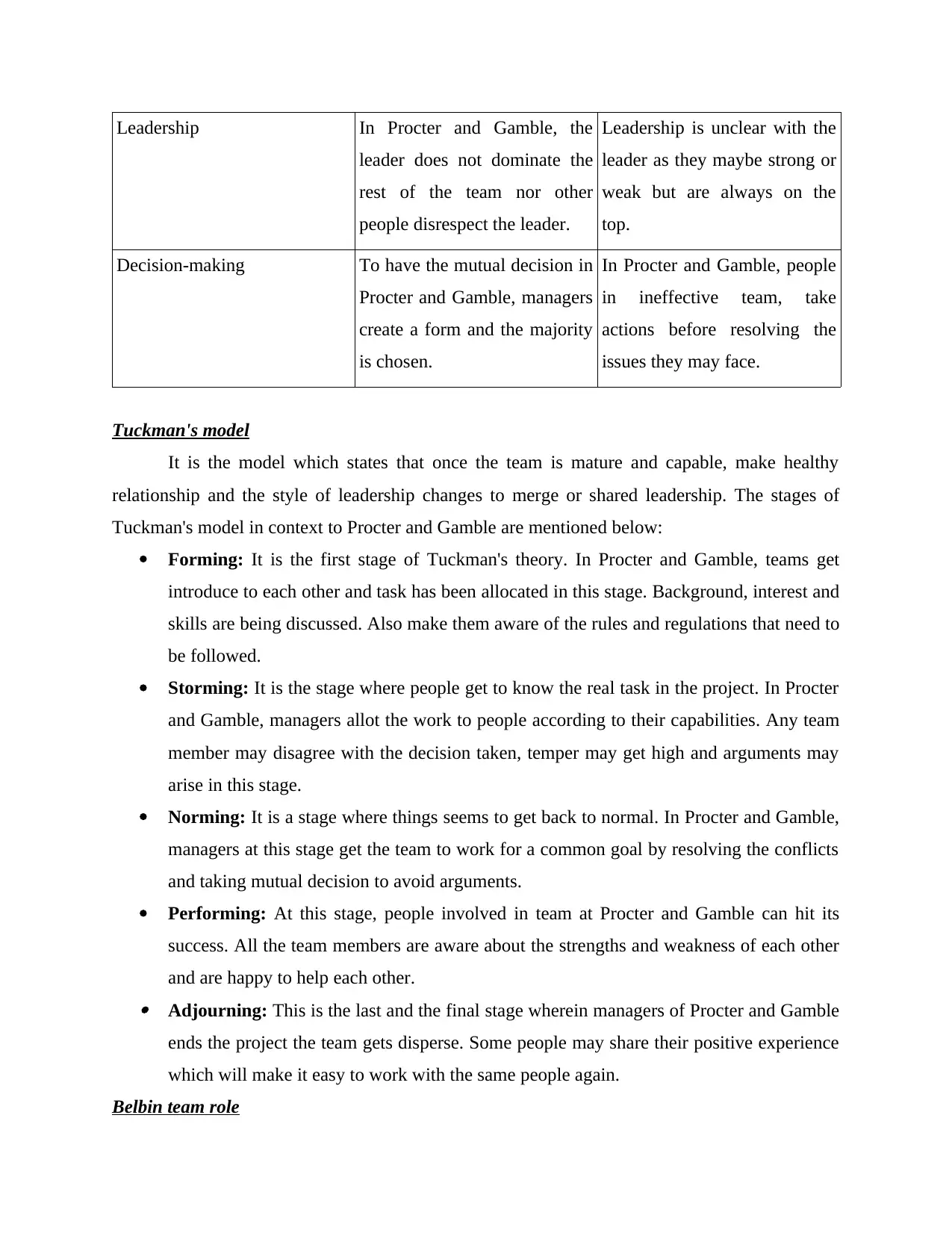
Leadership In Procter and Gamble, the
leader does not dominate the
rest of the team nor other
people disrespect the leader.
Leadership is unclear with the
leader as they maybe strong or
weak but are always on the
top.
Decision-making To have the mutual decision in
Procter and Gamble, managers
create a form and the majority
is chosen.
In Procter and Gamble, people
in ineffective team, take
actions before resolving the
issues they may face.
Tuckman's model
It is the model which states that once the team is mature and capable, make healthy
relationship and the style of leadership changes to merge or shared leadership. The stages of
Tuckman's model in context to Procter and Gamble are mentioned below:
Forming: It is the first stage of Tuckman's theory. In Procter and Gamble, teams get
introduce to each other and task has been allocated in this stage. Background, interest and
skills are being discussed. Also make them aware of the rules and regulations that need to
be followed.
Storming: It is the stage where people get to know the real task in the project. In Procter
and Gamble, managers allot the work to people according to their capabilities. Any team
member may disagree with the decision taken, temper may get high and arguments may
arise in this stage.
Norming: It is a stage where things seems to get back to normal. In Procter and Gamble,
managers at this stage get the team to work for a common goal by resolving the conflicts
and taking mutual decision to avoid arguments.
Performing: At this stage, people involved in team at Procter and Gamble can hit its
success. All the team members are aware about the strengths and weakness of each other
and are happy to help each other. Adjourning: This is the last and the final stage wherein managers of Procter and Gamble
ends the project the team gets disperse. Some people may share their positive experience
which will make it easy to work with the same people again.
Belbin team role
leader does not dominate the
rest of the team nor other
people disrespect the leader.
Leadership is unclear with the
leader as they maybe strong or
weak but are always on the
top.
Decision-making To have the mutual decision in
Procter and Gamble, managers
create a form and the majority
is chosen.
In Procter and Gamble, people
in ineffective team, take
actions before resolving the
issues they may face.
Tuckman's model
It is the model which states that once the team is mature and capable, make healthy
relationship and the style of leadership changes to merge or shared leadership. The stages of
Tuckman's model in context to Procter and Gamble are mentioned below:
Forming: It is the first stage of Tuckman's theory. In Procter and Gamble, teams get
introduce to each other and task has been allocated in this stage. Background, interest and
skills are being discussed. Also make them aware of the rules and regulations that need to
be followed.
Storming: It is the stage where people get to know the real task in the project. In Procter
and Gamble, managers allot the work to people according to their capabilities. Any team
member may disagree with the decision taken, temper may get high and arguments may
arise in this stage.
Norming: It is a stage where things seems to get back to normal. In Procter and Gamble,
managers at this stage get the team to work for a common goal by resolving the conflicts
and taking mutual decision to avoid arguments.
Performing: At this stage, people involved in team at Procter and Gamble can hit its
success. All the team members are aware about the strengths and weakness of each other
and are happy to help each other. Adjourning: This is the last and the final stage wherein managers of Procter and Gamble
ends the project the team gets disperse. Some people may share their positive experience
which will make it easy to work with the same people again.
Belbin team role
Paraphrase This Document
Need a fresh take? Get an instant paraphrase of this document with our AI Paraphraser
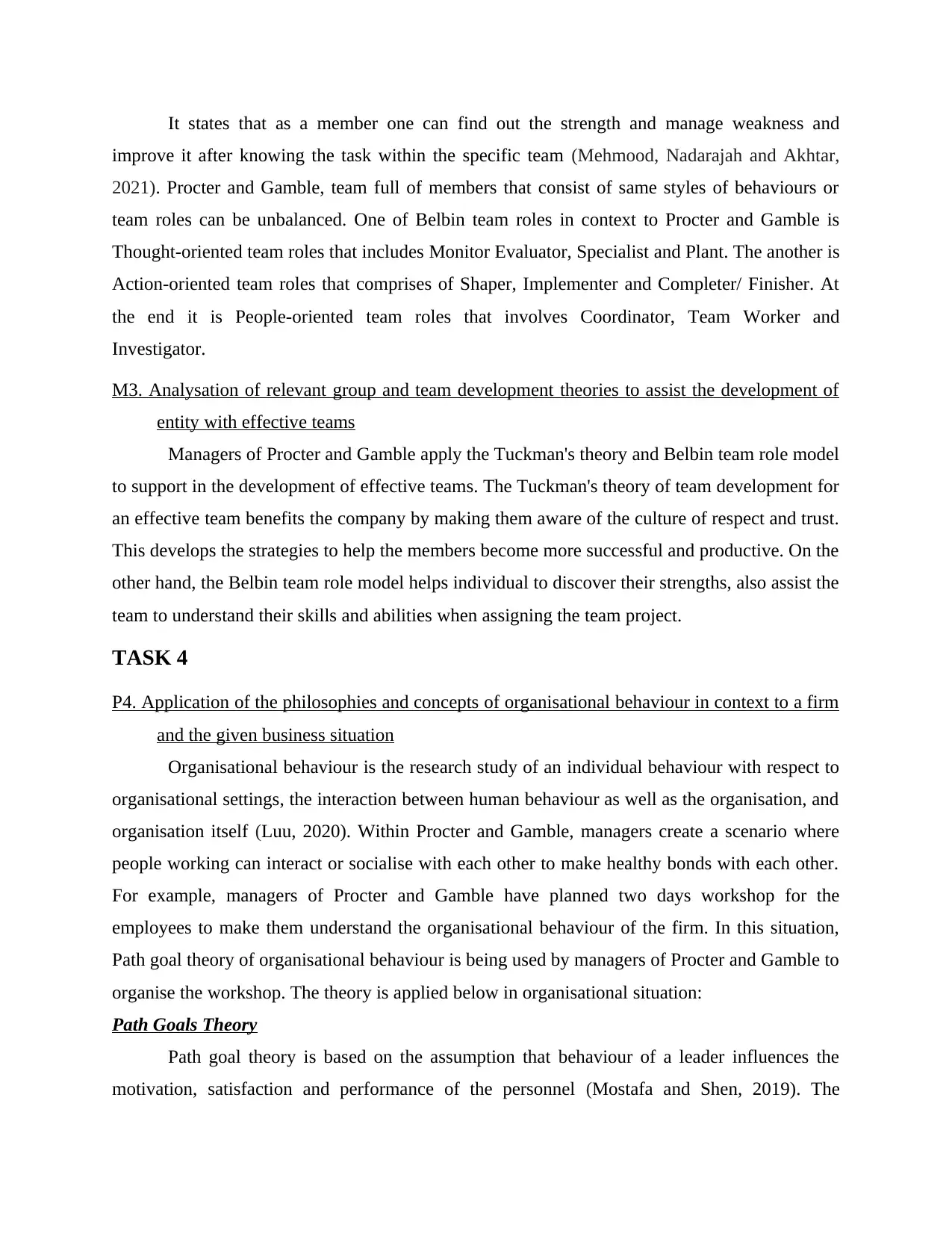
It states that as a member one can find out the strength and manage weakness and
improve it after knowing the task within the specific team (Mehmood, Nadarajah and Akhtar,
2021). Procter and Gamble, team full of members that consist of same styles of behaviours or
team roles can be unbalanced. One of Belbin team roles in context to Procter and Gamble is
Thought-oriented team roles that includes Monitor Evaluator, Specialist and Plant. The another is
Action-oriented team roles that comprises of Shaper, Implementer and Completer/ Finisher. At
the end it is People-oriented team roles that involves Coordinator, Team Worker and
Investigator.
M3. Analysation of relevant group and team development theories to assist the development of
entity with effective teams
Managers of Procter and Gamble apply the Tuckman's theory and Belbin team role model
to support in the development of effective teams. The Tuckman's theory of team development for
an effective team benefits the company by making them aware of the culture of respect and trust.
This develops the strategies to help the members become more successful and productive. On the
other hand, the Belbin team role model helps individual to discover their strengths, also assist the
team to understand their skills and abilities when assigning the team project.
TASK 4
P4. Application of the philosophies and concepts of organisational behaviour in context to a firm
and the given business situation
Organisational behaviour is the research study of an individual behaviour with respect to
organisational settings, the interaction between human behaviour as well as the organisation, and
organisation itself (Luu, 2020). Within Procter and Gamble, managers create a scenario where
people working can interact or socialise with each other to make healthy bonds with each other.
For example, managers of Procter and Gamble have planned two days workshop for the
employees to make them understand the organisational behaviour of the firm. In this situation,
Path goal theory of organisational behaviour is being used by managers of Procter and Gamble to
organise the workshop. The theory is applied below in organisational situation:
Path Goals Theory
Path goal theory is based on the assumption that behaviour of a leader influences the
motivation, satisfaction and performance of the personnel (Mostafa and Shen, 2019). The
improve it after knowing the task within the specific team (Mehmood, Nadarajah and Akhtar,
2021). Procter and Gamble, team full of members that consist of same styles of behaviours or
team roles can be unbalanced. One of Belbin team roles in context to Procter and Gamble is
Thought-oriented team roles that includes Monitor Evaluator, Specialist and Plant. The another is
Action-oriented team roles that comprises of Shaper, Implementer and Completer/ Finisher. At
the end it is People-oriented team roles that involves Coordinator, Team Worker and
Investigator.
M3. Analysation of relevant group and team development theories to assist the development of
entity with effective teams
Managers of Procter and Gamble apply the Tuckman's theory and Belbin team role model
to support in the development of effective teams. The Tuckman's theory of team development for
an effective team benefits the company by making them aware of the culture of respect and trust.
This develops the strategies to help the members become more successful and productive. On the
other hand, the Belbin team role model helps individual to discover their strengths, also assist the
team to understand their skills and abilities when assigning the team project.
TASK 4
P4. Application of the philosophies and concepts of organisational behaviour in context to a firm
and the given business situation
Organisational behaviour is the research study of an individual behaviour with respect to
organisational settings, the interaction between human behaviour as well as the organisation, and
organisation itself (Luu, 2020). Within Procter and Gamble, managers create a scenario where
people working can interact or socialise with each other to make healthy bonds with each other.
For example, managers of Procter and Gamble have planned two days workshop for the
employees to make them understand the organisational behaviour of the firm. In this situation,
Path goal theory of organisational behaviour is being used by managers of Procter and Gamble to
organise the workshop. The theory is applied below in organisational situation:
Path Goals Theory
Path goal theory is based on the assumption that behaviour of a leader influences the
motivation, satisfaction and performance of the personnel (Mostafa and Shen, 2019). The
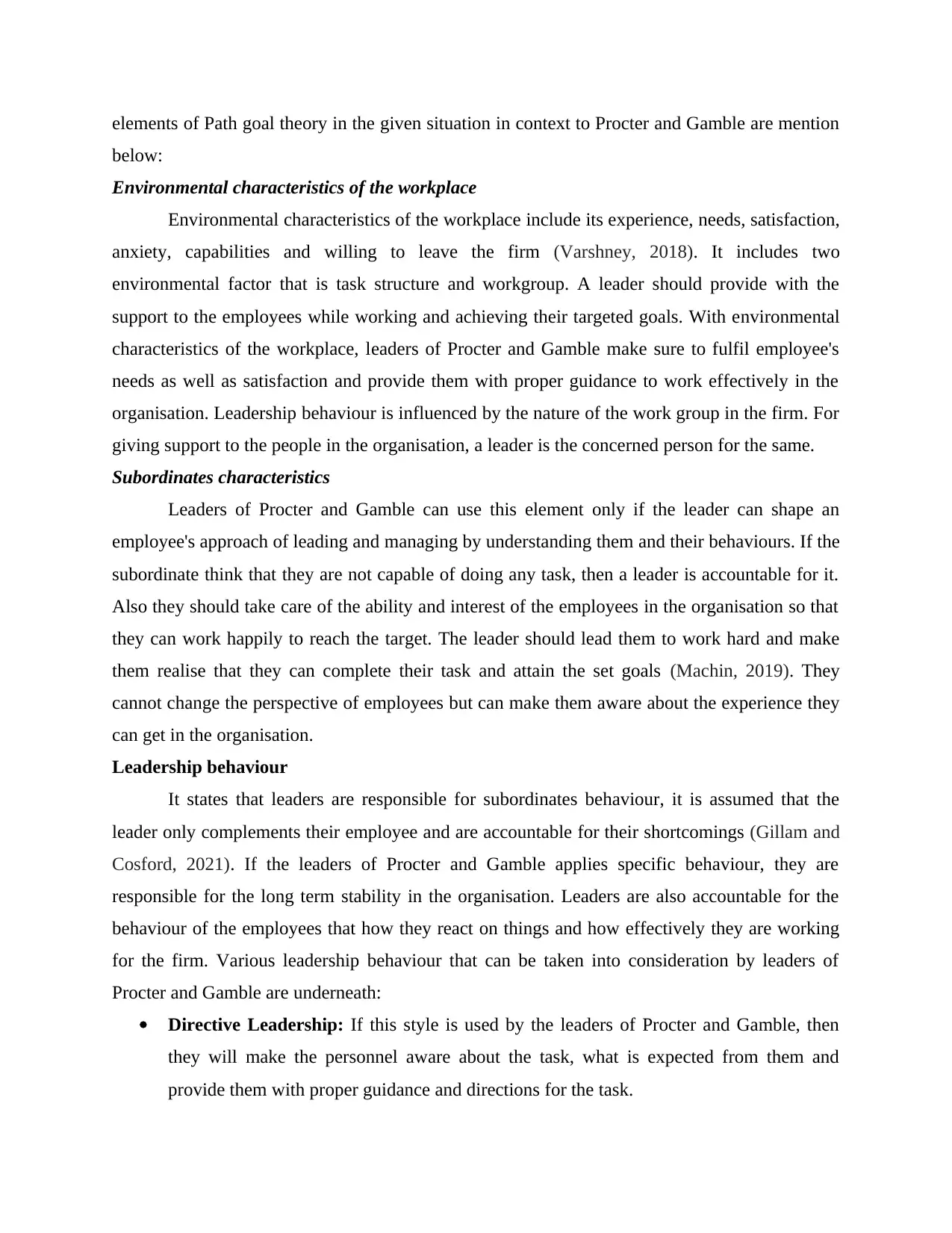
elements of Path goal theory in the given situation in context to Procter and Gamble are mention
below:
Environmental characteristics of the workplace
Environmental characteristics of the workplace include its experience, needs, satisfaction,
anxiety, capabilities and willing to leave the firm (Varshney, 2018). It includes two
environmental factor that is task structure and workgroup. A leader should provide with the
support to the employees while working and achieving their targeted goals. With environmental
characteristics of the workplace, leaders of Procter and Gamble make sure to fulfil employee's
needs as well as satisfaction and provide them with proper guidance to work effectively in the
organisation. Leadership behaviour is influenced by the nature of the work group in the firm. For
giving support to the people in the organisation, a leader is the concerned person for the same.
Subordinates characteristics
Leaders of Procter and Gamble can use this element only if the leader can shape an
employee's approach of leading and managing by understanding them and their behaviours. If the
subordinate think that they are not capable of doing any task, then a leader is accountable for it.
Also they should take care of the ability and interest of the employees in the organisation so that
they can work happily to reach the target. The leader should lead them to work hard and make
them realise that they can complete their task and attain the set goals (Machin, 2019). They
cannot change the perspective of employees but can make them aware about the experience they
can get in the organisation.
Leadership behaviour
It states that leaders are responsible for subordinates behaviour, it is assumed that the
leader only complements their employee and are accountable for their shortcomings (Gillam and
Cosford, 2021). If the leaders of Procter and Gamble applies specific behaviour, they are
responsible for the long term stability in the organisation. Leaders are also accountable for the
behaviour of the employees that how they react on things and how effectively they are working
for the firm. Various leadership behaviour that can be taken into consideration by leaders of
Procter and Gamble are underneath:
Directive Leadership: If this style is used by the leaders of Procter and Gamble, then
they will make the personnel aware about the task, what is expected from them and
provide them with proper guidance and directions for the task.
below:
Environmental characteristics of the workplace
Environmental characteristics of the workplace include its experience, needs, satisfaction,
anxiety, capabilities and willing to leave the firm (Varshney, 2018). It includes two
environmental factor that is task structure and workgroup. A leader should provide with the
support to the employees while working and achieving their targeted goals. With environmental
characteristics of the workplace, leaders of Procter and Gamble make sure to fulfil employee's
needs as well as satisfaction and provide them with proper guidance to work effectively in the
organisation. Leadership behaviour is influenced by the nature of the work group in the firm. For
giving support to the people in the organisation, a leader is the concerned person for the same.
Subordinates characteristics
Leaders of Procter and Gamble can use this element only if the leader can shape an
employee's approach of leading and managing by understanding them and their behaviours. If the
subordinate think that they are not capable of doing any task, then a leader is accountable for it.
Also they should take care of the ability and interest of the employees in the organisation so that
they can work happily to reach the target. The leader should lead them to work hard and make
them realise that they can complete their task and attain the set goals (Machin, 2019). They
cannot change the perspective of employees but can make them aware about the experience they
can get in the organisation.
Leadership behaviour
It states that leaders are responsible for subordinates behaviour, it is assumed that the
leader only complements their employee and are accountable for their shortcomings (Gillam and
Cosford, 2021). If the leaders of Procter and Gamble applies specific behaviour, they are
responsible for the long term stability in the organisation. Leaders are also accountable for the
behaviour of the employees that how they react on things and how effectively they are working
for the firm. Various leadership behaviour that can be taken into consideration by leaders of
Procter and Gamble are underneath:
Directive Leadership: If this style is used by the leaders of Procter and Gamble, then
they will make the personnel aware about the task, what is expected from them and
provide them with proper guidance and directions for the task.
⊘ This is a preview!⊘
Do you want full access?
Subscribe today to unlock all pages.

Trusted by 1+ million students worldwide
1 out of 16
Related Documents
Your All-in-One AI-Powered Toolkit for Academic Success.
+13062052269
info@desklib.com
Available 24*7 on WhatsApp / Email
![[object Object]](/_next/static/media/star-bottom.7253800d.svg)
Unlock your academic potential
Copyright © 2020–2025 A2Z Services. All Rights Reserved. Developed and managed by ZUCOL.




